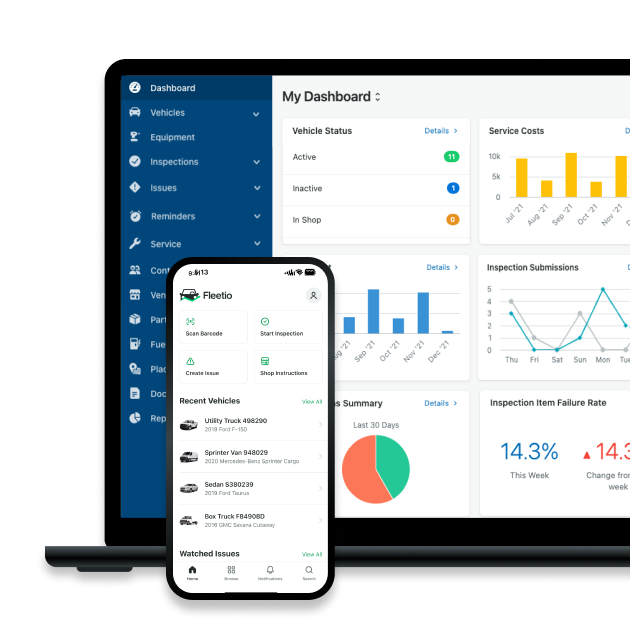Improving ROI Through Tire Management
Tires are so much more than a component you replace every X number of miles. Perhaps more than any other consumable, tires have a direct impact on your fleet’s fuel economy, safety and bottom line.
Feb 7, 2024
6 min read

While a fresh set of tires will never set you back as much as a replacement camshaft or transmission system, tires should never be deprioritized within your preventive maintenance program. In fact, by closely monitoring their tires, organizations can actually reduce many of the costs of managing a fleet from multiple angles and improve the return on investment (ROI) they get from their vehicles.
Here are three ways stepping up your tire management can reduce your fleet’s recurring costs:
Better fuel economy
When it comes to how far a vehicle can travel on a gallon of gas, the thermal efficiency of its engine is only part of the equation. A multitude of factors including driver behavior, the weight of its cargo and, you guessed it, the state of its tires all impact a vehicle’s fuel economy.
As tires lose pressure, the more they start to resemble party balloons three days after everyone’s left. Soft and saggy, underinflated tires have larger “footprints” (i.e. areas that contact the road) than their counterparts at proper PSI levels. This greater surface area results in an increase in rolling resistance that forces engines to work harder—and the more engines exert themselves, the more fuel-thirsty they become.
According to the U.S. Department of Energy, fleets can improve their vehicles’ gas mileage by 0.6% on average (or up to 3% in ideal scenarios) by keeping their tires properly inflated. And if those percentages don’t impress you, remember that many fleets spend more on fuel than any other recurring expense. Over time (and especially when fuel prices spike), even a modest 0.6% improvement in fuel economy can result in serious savings.
Did you know?
When Popular Mechanics put overinflated tires to the test, tires 13 PSI over their recommended pressure achieved a mere 0.12% improvement in fuel economy.
It’s worth noting that, contrary to popular belief, overinflating your tires won’t meaningfully improve your vehicles’ fuel consumption. While it’s true that the more a tire is inflated the less rolling resistance it has, going beyond recommended PSI levels only returns marginal improvements in gas mileage.
Additionally, overinflated tires tend to bulge in the middle, resulting in a smaller footprint that’s less like a rectangle with rounded corners (a la a properly inflated tire) and more like an oval. This ovular shape concentrates friction to a narrow stripe along the tire’s center, accelerating wear and tear. At the end of the day, any fuel savings fleets stand to gain from overinflating their tires are almost guaranteed to be lost to more frequent tire replacements.
Reduced unplanned downtime
Time is money in many aspects of business, including fleet operations. By keeping unplanned downtime to a minimum, fleets can extract greater value from their vehicles by accomplishing more work. Tire management helps fleets stay productive by reducing some of the most common issues that sideline fleet vehicles.
Some fleet experts estimate that up to 95% of tire failures are caused by underinflation. When below recommended PSI levels, tire sidewalls flex a lot more than usual, which causes heat to build up. This pent-up heat can degrade rubber rather quickly and often results in blowouts.
But while flat tires at the wrong time can temporarily grind a fleet vehicle’s productivity to a halt, they pale in comparison to just about any accident. In addition to the obvious risk they pose to driver safety, accidents can put vehicles out of commission indefinitely. And while not all accidents are preventable, having well-maintained tires can mean the difference between a close call and a serious collision.
Did you know?
In 60-mile per hour tests on a wet, flat road, Hunter Engineering Company found that tires with a tread depth of 6/32 of an inch stopped 100 feet earlier than tires with a tread depth of 2/32 of an inch.
Instead of gripping the road as intended, underinflated tires limply slide around, producing friction without traction. This slipperiness makes steering less responsive, which impedes drivers’ ability to evade sudden danger. This problem is especially apparent in rainy and snowy driving conditions.
Tires with shallow tread depths pose a serious safety risk to drivers. Numerous studies have shown that tires with worn down treads take significantly longer distances to come to a complete stop. And the longer it takes for a vehicle to brake, the faster its drivers’ reflexes need to be in order to avoid an accident.
By keeping a watchful eye over their tires and making sure they are consistently safe to drive, fleets can improve personnel safety while minimizing disruptions to productivity.
See how software can help you get the most out of your tires
Improved compliance
Every year, the Commercial Vehicle Safety Alliance (CVSA) publishes the most common violations inspectors find during their “International Roadcheck” compliance enforcement initiative. For multiple years running at this point, tire-related infractions have been the second-most prevalent violation found during these events, only surpassed by faulty brake systems in frequency.
Did you know?
Last year, inspectors discovered 3,368 tire-related violations during the CVSA International Roadcheck. Incompliant tires represented 19.3% of all infractions found during the event.
Data published by the Federal Motor Carrier Safety Administration (FMCSA) further suggests that far too many fleets are neglecting the health of their tires.
Not only does such negligence compromise driver safety, it also exposes fleets to hefty fines and losses in productivity from vehicles being deemed out of service. In addition to costing up to thousands of dollars, fines for failing to comply with federal standards can also increase a fleet’s insurance premiums.
To maintain compliance, fleets should familiarize themselves with all federal, state and local tire regulations relevant to the areas they operate in. Federal regulations span everything from tread depth and inflation level to regrooving and load restrictions, so fleets should give them particular focus.
Enhancing your tire management with software
Keeping tabs on every tire you own becomes increasingly difficult as your fleet grows. Thankfully, Fleetio’s tire management software provides fleets with all-encompassing visibility over the health, service histories and costs of their tires.
With Fleetio, you can instantly pull up key details of any tire in your fleet like when it was installed, how many miles it has on it and what maintenance actions have been done on it. Anytime access to this information helps fleets know what to look for when conducting tire inspections, when to perform a tire alignment or when to replace a tire entirely based on data, not intuition.
Additionally, Fleetio makes fleet expense tracking by breaking down all the costs your operations accrue (including tires). The ability to follow costs in real-time via dashboards, drill deep into your expense data with customizable reports or share findings with stakeholders in your organization allows you to better understand your fleet and find ways to make it more efficient and productive.
Discover why fleets choose Fleetio
Thousands of organizations across countless industries rely on Fleetio to manage their fleet activities. No matter the size of your fleet, Fleetio can help you track, analyze and improve your operations.
Book a demo
Fleet Content Specialist
Through interviews, blog posts and webinars, Alex covers the tactics and technologies exceptional fleet managers use to achieve results. By sharing their success stories, his work aims to inform and inspire fleet professionals of all stripes.
LinkedIn|View articles by Alex BorgReady to get started?
Join thousands of satisfied customers using Fleetio
Questions? Call us at 1-800-975-5304
